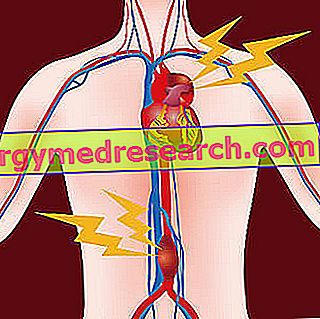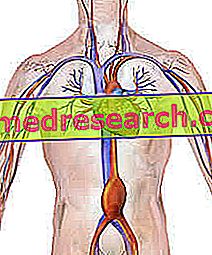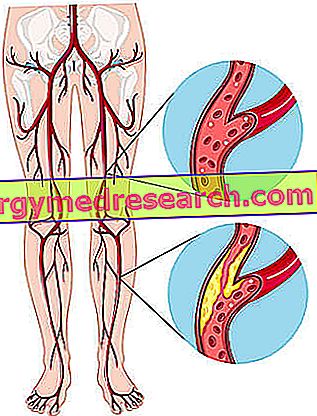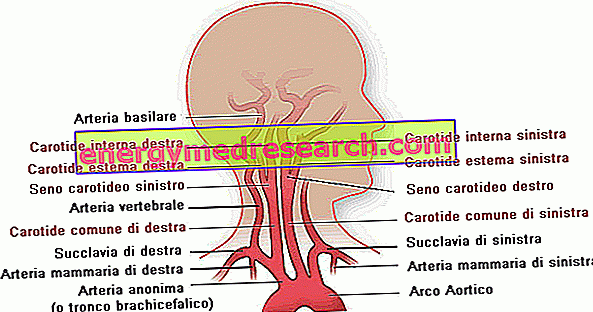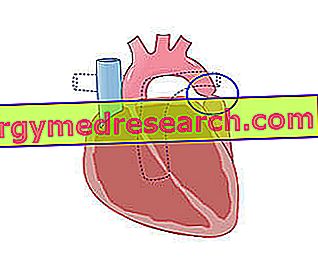Definition Thrombophlebitis is the term used to indicate the inflammation of a vein wall caused by the formation of a blood clot, or the formation of a thrombus. Thrombophlebitis can affect superficial veins (therefore we speak of superficial thrombophlebitis, nowadays called simply "thrombophlebitis"), or it can involve the deep veins (in this case we speak of deep vein thrombosis)
Category cardiovascular diseases
Generality An aortic aneurysm is a permanent abnormal dilation of a short section of aorta. Despite the lack of a correlated symptomatology, the presence of an aneurysm of the aorta represents a serious threat for the survival of the patient, since from a rupture of it it results an often fatal internal hemorrhage
Generality An abdominal aortic aneurysm is a permanent pathological dilation, a sort of bulge similar to a ball, which affects the wall of the largest artery of the abdomen. Figure: illustration depicting an aneurysm (swelling) of the abdominal aorta. From the site: wikipedia.org Although the precise causes are currently unknown, doctors believe that the onset of an abdominal aneurysm is favored by various factors, such as hypertension, aging, cigarette smoking, etc
Generality Horton 's arteritis (or giant cell arteritis ) is an inflammatory process that affects medium and large-sized arteries. Although it can affect any arterial vessel, inflammation prefers arteries that cross the head , particularly the temples and neck . Not surprisingly, Horton's arteritis is also known with the third synonym of temporal arteritis
Generality Peripheral arteriopathy is a vascular pathology, characterized by a more or less severe occlusion of the arteries destined to supply the limbs, trunk or head. Also known as peripheral arterial disease, peripheral arterial disease determines, due to the aforementioned phenomenon of arterial occlusion, a reduction in the supply of oxygenated blood to the anatomical districts involved and a suffering of these districts due to the lack of oxygen and nutrients
Generality The right bundle branch block is a cardiac condition, which occurs due to the presence of a lesion or a disorder capable of blocking the electrical signal along the fascicle of the right bundle branch of the His bundle. Thus, the right bundle branch block is an anomaly of the so-called electrical conduction system of the heart
Anatomy and Functions Carotid arteries are two large blood vessels located at the sides of the neck; together with the vertebral arteries, the carotids with their numerous branches supply the head and neck, transporting oxygen-rich blood from the heart to the brain and to the facial structures . The left common carotid artery derives directly from the aortic arch, while the right one arises from the innominate (or anonymous) artery
Generality Aortic coarctation is the medical expression that indicates an abnormal narrowing along the initial part of the aorta, near the so-called arterial ligament. Almost always of a congenital nature, the aortic coarctation subjects the heart of the patient to a greater effort than normal, in order to spread the blood beyond the narrowing; this effort can have several consequences, including: hypertension in the upper limbs combined with hypotension in the lower limbs, respiratory problems, slowing of growth, difficulty in eating, cyanosis and chest pain
Generality Cryoglobulinemia is a form of systemic vasculitis, characterized by the presence, in the blood, of immune complexes that precipitate at the base temperatures. These immune complexes are known as cryoglobulins. The effects of cryoglobulinemic vasculitis are many and can occur in several parts of the body: skin, nerves, kidneys, heart, brain, gastrointestinal tract and joints
Generality Phlebitis is the medical term that indicates the presence of an inflammation in a vein. Supported in most cases by the presence of a thrombus, phlebitis recognizes various causes; among these, special mention should be made of: damage to venous walls (which may, for example, arise from trauma or infection), prolonged immobility, the phenomenon of varicose veins and congenital disorders of blood coagulation
Generality Wegener's granulomatosis is a rare inflammatory disease that affects medium and small-caliber blood vessels. In other words, it is a vasculitis. Figure: a granuloma, under the microscope. Image from: //en.wikipedia.org/wiki/Granuloma Because of the disease, the blood flow that passes through the blood vessels affected by inflammation is reduced; to pay the consequences are the organs of the body, no longer sprayed properly


